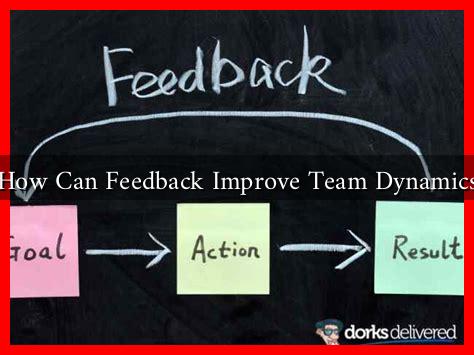-
Table of Contents
- How Can Feedback Improve Team Dynamics
- The Importance of Feedback in Teams
- Types of Feedback
- How Feedback Enhances Team Dynamics
- 1. Fostering Open Communication
- 2. Building Trust Among Team Members
- 3. Encouraging Accountability
- 4. Promoting Continuous Improvement
- Implementing Effective Feedback Mechanisms
- Case Study: The Impact of Feedback at Microsoft
- Conclusion
How Can Feedback Improve Team Dynamics
In today’s fast-paced work environment, effective team dynamics are crucial for achieving organizational goals. One of the most powerful tools for enhancing these dynamics is feedback. When utilized correctly, feedback can foster collaboration, improve communication, and ultimately lead to higher productivity. This article explores how feedback can improve team dynamics, supported by research, examples, and actionable insights.
The Importance of Feedback in Teams
Feedback serves as a vital communication channel within teams. It allows team members to understand their strengths and areas for improvement, fostering a culture of continuous learning. According to a study by Gallup, teams that receive regular feedback are 14.9% more productive than those that do not. This statistic underscores the importance of integrating feedback into team processes.
Types of Feedback
Feedback can be categorized into several types, each serving a unique purpose in enhancing team dynamics:
- Positive Feedback: Reinforces good behavior and performance, motivating team members to continue excelling.
- Constructive Feedback: Offers specific suggestions for improvement, helping team members develop their skills.
- Peer Feedback: Encourages team members to provide insights to one another, fostering a collaborative environment.
- 360-Degree Feedback: Involves collecting feedback from all levels within the organization, providing a comprehensive view of performance.
How Feedback Enhances Team Dynamics
Feedback can significantly improve team dynamics in various ways:
1. Fostering Open Communication
When feedback is encouraged, team members feel more comfortable sharing their thoughts and ideas. This openness leads to better communication, which is essential for effective collaboration. For instance, Google’s Project Aristotle found that psychological safety—where team members feel safe to take risks and be vulnerable—was a key factor in high-performing teams. Regular feedback sessions can help establish this safety.
2. Building Trust Among Team Members
Trust is a cornerstone of effective teamwork. When team members provide and receive feedback, it demonstrates a commitment to each other’s growth. A study published in the Journal of Applied Psychology found that teams with high levels of trust are more likely to engage in constructive feedback, leading to improved performance.
3. Encouraging Accountability
Feedback creates a sense of accountability within teams. When team members know they will receive feedback on their performance, they are more likely to take ownership of their tasks. This accountability can lead to higher quality work and a stronger commitment to team goals.
4. Promoting Continuous Improvement
Feedback encourages a culture of continuous improvement. Teams that regularly assess their performance and seek feedback are more likely to adapt and innovate. For example, companies like Amazon and Microsoft have implemented feedback loops that allow teams to iterate on their projects quickly, leading to enhanced products and services.
Implementing Effective Feedback Mechanisms
To harness the power of feedback, organizations should implement effective feedback mechanisms:
- Regular Check-Ins: Schedule consistent one-on-one and team meetings to discuss performance and provide feedback.
- Anonymous Surveys: Use tools like SurveyMonkey or Google Forms to gather honest feedback from team members.
- Training Programs: Invest in training for team leaders on how to give and receive feedback effectively.
- Feedback Culture: Encourage a culture where feedback is seen as a positive and necessary part of growth.
Case Study: The Impact of Feedback at Microsoft
Microsoft is a prime example of how feedback can transform team dynamics. Under CEO Satya Nadella, the company shifted its culture to emphasize growth mindset and continuous feedback. This change led to improved collaboration across teams and a significant increase in employee engagement. According to Microsoft’s internal surveys, employees reported feeling more valued and connected to their teams, resulting in higher productivity and innovation.
Conclusion
Feedback is a powerful tool that can significantly improve team dynamics. By fostering open communication, building trust, encouraging accountability, and promoting continuous improvement, organizations can create a thriving team environment. Implementing effective feedback mechanisms is essential for harnessing these benefits. As demonstrated by companies like Microsoft, a culture of feedback can lead to enhanced performance and innovation. Embracing feedback not only strengthens individual team members but also propels the entire organization toward success.
For further reading on the importance of feedback in teams, you can explore resources from Gallup and Harvard Business Review.


